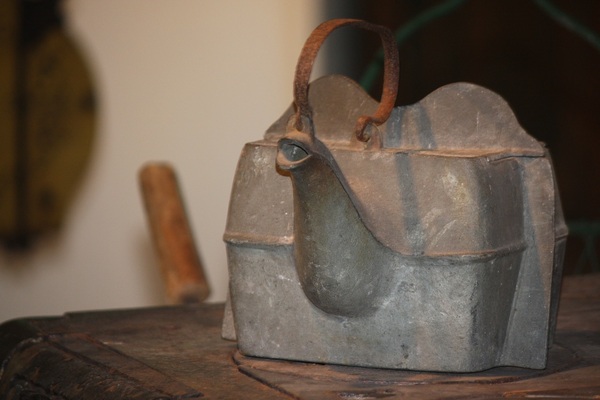
Telling history through cookware is the concept of the East Hampton Historical Society’s “What’s Cooking: 300 Years of East Hampton’s History” exhibit, now on view at the Clinton Academy Museum.
During a recent walkthrough, Director Richard Barons gave a tour of the museum, which was chock-full of utensils—plain and fancy—and were divided into sections including: Baking, Butter, Montauket Made, Redware, Treenware, and Cooking at the Hearth.
“The Goddess” greets visitors at the front door of the museum. A black cast-iron Stewart stove made in Troy, New York in about 1895, the “Ideal” model
resided at the Osborne House on Newtown Lane and was adapted over the years from a wood-burning stove to a coal burner and eventually a gas cooker. The stove was used until five years ago when it came to rest at the museum.
“The grill is a work of art in itself,” Mr. Barons said.
He pointed out that a similar grill had sold at the Mulford Farm Antique Show across the street for $400.
“It’s a pretty amazing machine,” he said of the stove, which had more contraptions on it than a modern-day luxury Viking stove. But a curved steel teapot, which travelled with “The Goddess,” had been a mystery until Mr. Barons realized it fit snugly into a warming spot on the face of the massive kitchen centerpiece.
Mr. Barons and his crew also had to figure out a wooden block with a knife attached. Too big and not sharp enough for cheese. A clam fit nicely in between the blade and the block, making for a perfect shucker. He also reported that he thought the basket the museum used for displaying clams was probably also used to put flowers on the front steps, serving double duty.
Unmistakable for their usage was a variety of cookie cutters.
“Oddly enough we found a lot of fish shapes,” said Mr. Barons.
Butter makers are also included in the exhibit. The largest butter churn, a Davis Swing Churn, was made by the Vermont Farm Machine Company and looked almost like a baby’s rocking cradle. Only a push was needed to keep the milk moving in its wooden bed.
A much smaller stone crock used as a butter churn was found at the Mulford farmhouse “shoved up under the eaves, along with 20 other things,” reported Mr. Barons.
He reminded his audience that butter was not refrigerated back in the olden days, and is still not in some places.
“It ruins the flavor,” he said as he showed off a Redware butter crock. “Even today, the French wouldn’t dream of putting butter in the refrigerator.”
Upon return from whaling voyages, butter prints, detailed wooden stamps carved by sailors at sea, were given as gifts to the woman of the house. Decorative details included in the ones on display at the Clinton Museum include a daisy, a sheaf of wheat, a star and a chicken.
One of the most interesting items included in the exhibit is an egg boiler, a small tin box with a timer on top that dips the eggs into hot water. Also on view were waffle irons, made by blacksmiths who crafted intricate decorative details and were quite a bit smaller than contemporary electric models.
The Montaukets carved the precursor for today’s Brillo pads—tiny bristles and a handle out of one piece of wood to wash pots and pans, much like larger brooms for floors. Additionally, there is a Native American mortar and pestle, carved from oak and tree roots, and dated 1740, on display along with carved wooden bowls of all shapes and sizes. One very special bowl, according to Mr. Barons, was turned from burl, and had “a bump that comes out on Ash trees like a wart,” which still looked brand new.
“Most of the other wooden bowls are cracked. You don’t find a cracked burl bowl,” said Mr. Barons.
As far as kitchen implements went, if it wasn’t made out of wood or metal it was earthenware, he added.
“So many people died from poisoning,” Mr. Barons said while stopped in front of a cabinet filled with earthenware. Thankfully, a type of “safe” gray clay was found in Perth Amboy, New Jersey in the 1780s, which replaced the red clay laced with lead.
Upon the discovery of the gray clay, New York City then became the center of American stoneware. To create safer surfaces and unique design detail, salt was used to create an acid-proof glaze and cobalt was used for decoration.
A striking display of mostly metal tools that were used for cooking at the open hearth lines the back wall of the museum. A chestnut roaster, pie lifter, flesh fork, skimmers, dippers, choppers and peels were on view.
Overall, life in the kitchen was more difficult and filled with strife back in the day than it is now, even down to the clothing that had to be worn for food preparation. Today’s East End cooks think nothing of whipping up breakfast, lunch or dinner while wearing beachwear but cooking in the past could be a dangerous undertaking: case in point, women had to wear wool dresses to retard flames.
“What’s Cooking: East Hampton Kitchens 1648–1948,” presented by the East Hampton Historical Society, will be on display at the Clinton Academy Museum in East Hampton through October 10. A curator’s tour will be held on Saturday, September 17, at 10 a.m. easthamptonhistory.org.